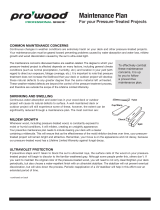
Solid Stains
It is recommended that “solid” wood sealers, which have more pigment, be used only on vertical projects such as
fences and siding. If used on decking, weather and foot traffic will wear through the pigment unevenly.
Semi-transparent Sealants
This type of wood sealant is suitable for vertical or horizontal surfaces such as deck boards, rails, siding and playground
equipment. There are several brands available in many colors.
Clear Sealants
This type of sealant has no pigment or color. It still offers some
protection from the weather, although wood fading will occur more
rapidly than color with sealants. Eventually, the wood will fade to
gray, which may or may not be the look you desire.
NOTE: We recommend using wood sealers that contain an ultra-
violet stabilizer. The stabilizer will not prevent eventual discoloration
to a weathered gray appearance, but it will slow the process down.
Whatever sealant you choose, follow the manufacturer’s instructions
carefully.
Periodic Maintenance
Apply cleaner/brightener every one to three years, depending on the
appearance of the outdoor project, followed by a coat of sealer to
rejuvenate the color of the wood.
If you decide to wait more than three years to perform your next
cleaning, you may want to use a power washer as your first step in the
cleaning process.
Restoring Gray, Weathered Wood
To restore gray, weathered wood, use a power washer, then clean
with a cleaner/brightener to help bring the wood back to its natural
appearance. This prepares the wood for better penetration of a
wood sealer. Work the brightener in with a stiff bristle brush, followed
by a thorough rinsing with water.
After the wood is completely dry, apply a wood sealer. If the sealer you use is colored, be sure to use a comparable
color or darker color than your original wood project.
The diagrams and instructions in this brochure are for illustrative purposes only, and are not meant to replace a licensed professional. Any construction or use of the product must
be in accordance with all local zoning and/or building codes. The consumer assumes all risks and liability associated with the construction or use of this product. The consumer or
contractor should take all necessary steps to ensure the safety of everyone involved in the project, including, but not limited to, wearing the appropriate safety equipment. Universal
Forest Products, Inc., makes no warranty, either express or implied, and shall not be liable for any damages, including consequential damages.
Add color to all your pressure
treated projects:
• Decks
• Fencing
• Porch and patio covers
• Trellis
• Window screening
• Picnic tables
• Gazebos
• Mobile home skirting
• Lattice
• Flower bed edging
• Storage areas
2801 East Beltline NE • Grand Rapids, MI 49525 • 1.800.598.9663 • ProWoodLumber.com
ProWood and the tree logo are registered trademarks of Universal Forest Products. Inc, in the U.S., Canada and Mexico. ©2012 Universal Forest Products. All rights reserved. 7157-7/13
Staining and Sealing Treated Lumber






